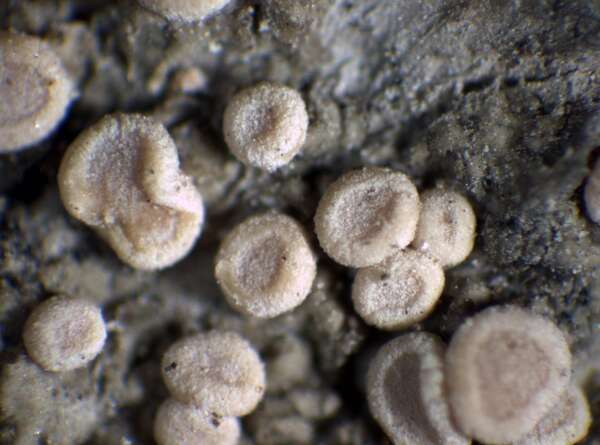Bacidia rosella (Pers.) De Not.
Giorn. Bot. Ital., 2, 1, 1: 190, 1846. Basionym: Lichen rosellus Pers. - Ann. Bot. (Usteri), 7: 25, 1794.
Synonyms: Biatora alabastrina W. Mann; Lecidea rosella (Pers.) Ach.
Distribution: N - Ven (Nascimbene & Marini 2010), Lomb, Piem (Isocrono & al. 2004, Matteucci & al. 2008b), Lig (Giordani & Incerti 2008, Giordani & al. 2009). C - Tosc (Tretiach & Nimis 1994, Brunialti & Frati 2010, Benesperi 2011, Brunialti & al. 2012b, Frati & Brunialti 2023), Umb (Panfili 2000, Ravera & al. 2006), Laz (Massari & Ravera 2002, Stofer 2006), Abr (Caporale & al. 2016), Mol (Caporale & al. 2008, Ravera & al. 2010, Caporale & Ravera 2020), Sar (Loi & al. 2000, Zedda 2002, Rizzi & al. 2011, Cossu 2013, Di Nuzzo & al. 2022). S - Camp (Aprile & al. 2003, 2003b, Garofalo & al. 2010, Catalano & al. 2016), Pugl (Nimis & Tretiach 1999, Gianfreda & Matino 2020), Bas (Nimis & Tretiach 1999, Potenza 2006, Potenza & al. 2010, Brackel 2011), Cal (Puntillo 1996), Si (Nimis & al. 1994, Ottonello & Salone 1994, Grillo & al. 2007, Ravera & al. 2023b, Ravera & al. 2024).
Description: Thallus crustose, thinly episubstratic, continuous, slightly cracked or rarely warted-areolate, mostly finely granulose, pale grey to greenish grey. Apothecia lecideine, 0.6-1.5(-3) mm across, sessile and constricted at base, pale pink, with a flat to finally convex, epruinose or slightly pruinose disc, and thin, usually paler, finally sometimes excluded proper margin. Proper exciple colourless, >80 μm wide laterally, of narrow, not distinctly radiating cell lumina with gelatinized walls which are thicker than the lumina, with evenly dispersed, very small, reddish crystals soluble in K, especially in upper part, the outer rim; epithecium colourless, inspersed with small crystals forming a sharply delimited layer; hymenium colourless, 75-85 μm high; paraphyses 0.8-1.2 μm thick at mid-level, the apical cells more or less clavate, to 3 μm wide; hypothecium colourless or very pale yellow. Asci 8-spored, clavate to cylindrical-clavate, the apical dome K/I+ dark blue with a pale, conical-pointed apical cushion (axial mass), the wall K/I-, but the thin outer gel K/I+ blue, Bacidia-type. Ascospores (3-)5-15-septate, hyaline, acicular, curved or sigmoid, 65-100 x (2.5-)3-4(-5) μm. Pycnidia colourless, half-immersed. Conidia 5-9-septate, hyaline, thread-like, slightly curved, 10-17 x 0.5-0.8 μm. Photobiont chlorococcoid, the cells 5-12 μm in diam. Spot tests: thallus and apothecia K-, C-, KC-, P-, UV-. Chemistry: thallus without lichen substances.Note: a mild-temperate to Mediterranean-Atlantic lichen found on deciduous trees (especially Acer and Fraxinus, but also on Quercus ilex) in humid, open forests and in woodlands along rivers, declining and perhaps extinct in Northern Italy, but still locally abundant in suitable habitats of Southern Italy. It is included in the Italian red list of epiphytic lichens as “Near-threatened” (Nascimbene & al. 2013c).
Growth form: Crustose
Substrata: bark
Photobiont: green algae other than Trentepohlia
Reproductive strategy: mainly sexual
Most common in areas with a humid-warm climate (e.g. most of Tyrrenian Italy)
Commonnes-rarity: (info)
Alpine belt: absent
Subalpine belt: absent
Oromediterranean belt: absent
Montane belt: extremely rare
Submediterranean belt: extremely rare
Padanian area: absent
Humid submediterranean belt: very rare
Humid mediterranean belt: extremely rare
Dry mediterranean belt: absent

Predictive model
Herbarium samples


P.L. Nimis; Owner: Department of Life Sciences, University of Trieste
Herbarium: TSB (9158)
2001/11/22

Photo by Maria Zardini, Museo di Storia Naturale di Venezia CC BY-SA 4.0
Ad cort. quercuum in nemore Montello raro.
Trevisan Lichenotheca Veneta 71

Zahlbruckner A. 1926. Lichenes (Flechten). In: Engler A. (ed.): Die natürlichen Pflanzenfamilien. 2nd ed., vol 8, W. Engelmann, Leipzig, 270 pp.

Ulrich Kirschbaum CC BY-SA 4.0 - Source: https://www.thm.de/lse/ulrich-kirschbaum/flechtenbilder
Central Europe; Germany: Hesse; rare.
(Coll/ident: Teuber).

Ulrich Kirschbaum CC BY-SA 4.0 - Source: https://www.thm.de/lse/ulrich-kirschbaum/flechtenbilder
SE Europe; N-Cyprus; SE of Girne; Beşparmak Mountains; between Alevkaya and Antiphonitis Monastery; 8. (Ident. A. Aptroot); on Cupressus sempervirens

Ulrich Kirschbaum CC BY-SA 4.0 - Source: https://www.thm.de/lse/ulrich-kirschbaum/flechtenbilder
SE Europe; N-Cyprus; SE of Girne; Beşparmak Mountains; between Alevkaya and Antiphonitis Monastery; 8. (Ident. A. Aptroot); on Cupressus sempervirens

Ulrich Kirschbaum CC BY-SA 4.0 - Source: https://www.thm.de/lse/ulrich-kirschbaum/flechtenbilder
SE Europe; N-Cyprus; SE of Girne; Beşparmak Mountains; between Alevkaya and Antiphonitis Monastery; 8. (Ident. A. Aptroot); on Cupressus sempervirens

Ulrich Kirschbaum CC BY-SA 4.0 - Source: https://www.thm.de/lse/ulrich-kirschbaum/flechtenbilder
SE Europe; N-Cyprus; SE of Girne; Beşparmak Mountains; between Alevkaya and Antiphonitis Monastery; 8. (Ident. A. Aptroot); on Cupressus sempervirens
Growth form: Crustose
Substrata: bark
Photobiont: green algae other than Trentepohlia
Reproductive strategy: mainly sexual
Most common in areas with a humid-warm climate (e.g. most of Tyrrenian Italy)
Commonnes-rarity: (info)
Alpine belt: absent
Subalpine belt: absent
Oromediterranean belt: absent
Montane belt: extremely rare
Submediterranean belt: extremely rare
Padanian area: absent
Humid submediterranean belt: very rare
Humid mediterranean belt: extremely rare
Dry mediterranean belt: absent

Predictive model
| Herbarium samples |


P.L. Nimis; Owner: Department of Life Sciences, University of Trieste
Herbarium: TSB (9158)
2001/11/22

Photo by Maria Zardini, Museo di Storia Naturale di Venezia CC BY-SA 4.0
Ad cort. quercuum in nemore Montello raro.
Trevisan Lichenotheca Veneta 71

Zahlbruckner A. 1926. Lichenes (Flechten). In: Engler A. (ed.): Die natürlichen Pflanzenfamilien. 2nd ed., vol 8, W. Engelmann, Leipzig, 270 pp.

Ulrich Kirschbaum CC BY-SA 4.0 - Source: https://www.thm.de/lse/ulrich-kirschbaum/flechtenbilder
Central Europe; Germany: Hesse; rare. (Coll/ident: Teuber).

Ulrich Kirschbaum CC BY-SA 4.0 - Source: https://www.thm.de/lse/ulrich-kirschbaum/flechtenbilder
SE Europe; N-Cyprus; SE of Girne; Beşparmak Mountains; between Alevkaya and Antiphonitis Monastery; 8. (Ident. A. Aptroot); on Cupressus sempervirens

Ulrich Kirschbaum CC BY-SA 4.0 - Source: https://www.thm.de/lse/ulrich-kirschbaum/flechtenbilder
SE Europe; N-Cyprus; SE of Girne; Beşparmak Mountains; between Alevkaya and Antiphonitis Monastery; 8. (Ident. A. Aptroot); on Cupressus sempervirens

Ulrich Kirschbaum CC BY-SA 4.0 - Source: https://www.thm.de/lse/ulrich-kirschbaum/flechtenbilder
SE Europe; N-Cyprus; SE of Girne; Beşparmak Mountains; between Alevkaya and Antiphonitis Monastery; 8. (Ident. A. Aptroot); on Cupressus sempervirens

 Index Fungorum
Index Fungorum
 GBIF
GBIF








